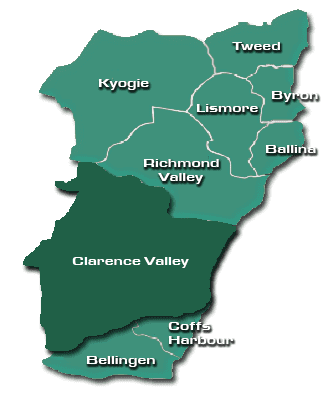Population 51,040 (2015 est) Area 10,441 km² | State electorate(s) Clarence Founded 24 February 2004 | |
 | ||
Established 24 February 2004 (2004-02-24) Points of interest Yamba Waters Holiday P, Bicentennial Museum, Grafton Regional Gallery, Hickey Island, Lawrence Museum Destinations | ||
Future planning tvc for older parent carers a clarence valley council project
Clarence Valley Council is a local government area in the Northern Rivers region of New South Wales, Australia.
Contents
- Future planning tvc for older parent carers a clarence valley council project
- Map of Clarence Valley NSW Australia
- Towns and localities
- Demographics
- Current composition and election method
- References
Map of Clarence Valley, NSW, Australia
The council services an area of 10,441 square kilometres (4,031 sq mi) and draws its name from the Clarence River, which flows through most of the council area. The area under management is adjacent to the Pacific Highway, the Gwydir Highway and the North Coast railway line. The Clarence Valley region includes the coastal plain and lower valleys of the Clarence and Nymboida river. Most of the valley is agricultural, however the oceanside towns of Yamba and Iluka are popular holiday resorts.
The council was formed in February 2004 by the amalgamation of the City of Grafton and Maclean Shire, and parts of Copmanhurst, Pristine Waters and Richmond Valley local government areas, and the activities of North Coast Water and Clarence River County Council.
The Mayor of Clarence Valley Council is Richie Williamson, an independent politician.
Towns and localities
Towns and localities in the Clarence Valley Council are:
Demographics
At the 2011 census, there were 49,665 people in the Clarence Valley local government area, of these 49.4 per cent were male and 50.6 per cent were female. Aboriginal and Torres Strait Islander people made up 5.7 per cent of the population which is more than double the national and state averages of 2.5 per cent. The median age of people in the Clarence Valley Council area was 46 years; some 10 years higher than the national median. Children aged 0 – 14 years made up 18.6 per cent of the population and people aged 65 years and over made up 21.3 per cent of the population. Of people in the area aged 15 years and over, 49.3 per cen% were married and 14.6% were either divorced or separated.
Population growth in the Clarence Valley Council area between the 2006 census and the 2011 Census was 3.15 per cent. When compared with total population growth of Australia for the same period, being 8.32 per cent, population growth in the Clarence Valley local government area was lower than the national average. The median weekly income for residents within the Clarence Valley Council area was significantly below the national average, being one of the factors that place the Clarence Valley Council area in an area of social disadvantage.
At the 2011 Census, the proportion of residents in the Clarence Valley local government area who stated their ancestry as Australian or Anglo-Saxon exceeded 82 per cent of all residents (national average was 65.2 per cent). In excess of 64 per cent of all residents in the Clarence Valley Council area nominated a religious affiliation with Christianity at the 2011 Census, which was above the national average of 50.2 per cent. Meanwhile, as at the Census date, compared to the national average, households in the Clarence Valley local government area had a significantly lower than average proportion (3.1 per cent) where two or more languages are spoken (national average was 20.4 per cent); and a significantly higher proportion (94.0 per cent) where English only was spoken at home (national average was 76.8 per cent).
Current composition and election method
Clarence Valley Council is composed of nine Councillors elected proportionally as one entire ward. All Councillors are elected for a fixed four-year term of office. The Mayor is elected by the Councillors at the first meeting of the Council. The most recent election was held on 10 September 2016, and the makeup of the Council is as follows:
The current Council, elected in 2016, in order of election, is:
